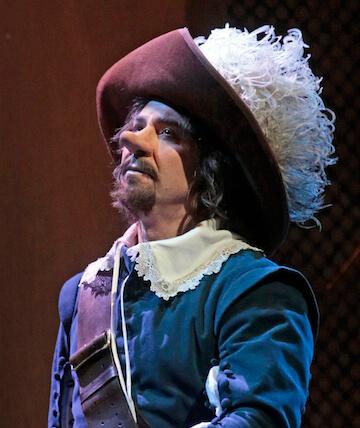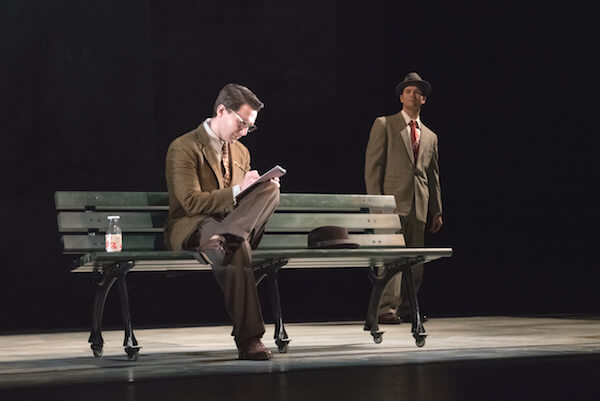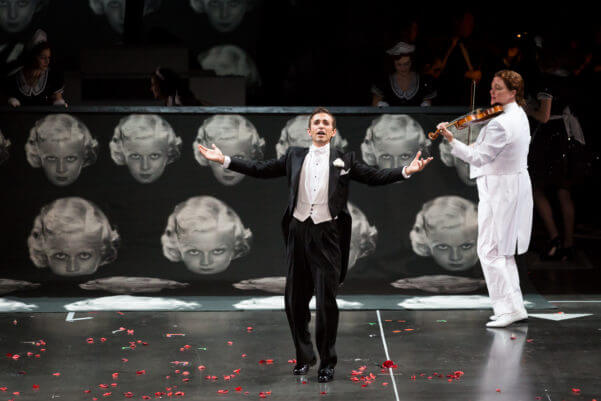The cast of Ottorino Respighi’s “La Campana Sommersa” in a co-production by the New York City Opera and the Teatro Lirico di Cagliari. | SARAH SCHATZ
BY ELI JACOBSON | The reconstituted New York City Opera is a strange beast. Often their performances are co-productions with other theaters, utilizing their artistic and performing resources. The orchestra and chorus are pick-up groups, not a resident ensemble. So the company identity and artistic profile seem to change radically with each production.
Last September’s double bill of Rachmaninov’s “Aleko” and Leoncavallo’s “I Pagliacci” was co-commissioned by Opera Carolina and had a whiff of regional opera about it: the unit set was workaday, the direction awkward, and the casting and orchestral playing uneven.
However, the NYCO production of Ottorino Respighi’s fractured fairy tale “La Campana Sommersa” (“The Sunken Bell”) was worthy of an international festival, with stunning design, freshly assured vocalism, and flawless orchestral playing. This co-production with the Teatro Lirico di Cagliari unveiled the first New York production of the opera since 1929.
New York City Opera shines with “La Campana Sommersa”
Respighi lavished his orchestral wizardry (more familiar to us in symphonic showpieces like “The Pines of Rome”) on a bizarre fable of man versus nature with no perceptible underlying moral message. The libretto by Claudio Guastalla (based on a play by Gerhart Hauptmann) concerns the forbidden love of married bell-maker Enrico for a supernatural wood elf Rautendelein that leads to the sinking of the church bell and the death of the bell-maker and his wife. The story closely mirrors Dvorák’s “Rusalka” but also has elements of “Das Rheingold” and “La Sylphide.” Similarly, Respighi’s impressionistic post-Romantic score has elements of Debussy and Wagner with only the barest hint of verismo. The vocal writing is often awkward and repetitive, with memorable melodies emerging from the orchestra pit.
Stage director Pier Francesco Maestrini tells this strange story straightforwardly without updating or symbolic stylization. Given the total unfamiliarity of the opera, it is helpful to see it presented as written. Video projections designed by Juan Guillermo Nova utilize high tech means to recreate a traditional neo-Romantic design aesthetic: lush forests out of 19th century prints by Arthur Rackham but with moving water, fire, and trees. The heightened realism of the magical landscapes seems simultaneously real and dreamlike — perfect for this opera.
The cast had both familiar and unfamiliar voices. Fabio Armiliato was forced to drop out as the tenor lead Enrico due to persistent sinusitis, but his alternate Marc Heller had the stamina to sing all four performances — twice on consecutive nights. (I first heard Heller over a decade ago at Caffè Taci uptown, where all night long he would perform one demanding aria after another; now he sings roles like Otello in Germany.) Heller’s dark baritonal tenor can turn dull with a worn timbre, but when the vocal line gets high and declamatory (as it often does in this opera) he rose to the challenge with tireless bright tones.
Soprano Brandie Sutton also commanded the difficulties of Rautendelein’s music with gleaming assurance. The vocal writing for the wood elf doesn’t require coloratura exactly but high-lying melismas sung full-voice over a heavy orchestra. Sutton’s rich vibrant tone danced over the difficulties without tiring.
Baritone Michael Chioldi as L’Ondino (analogous to the Water Sprite in “Rusalka”) sang and acted with the same dash and assurance he displayed as the company’s Scarpia last year. Chioldi’s voice is superior to several current Met baritones singing his repertory.
Kristin Sampson’s dark, tense soprano brought emotional depth to the one scene given to Enrico’s wife Magda. Renata Lamanda as the Wood Witch was commanding and idiomatic with her smoldering mezzo-soprano. Bass Philip Cokorinos made the Curate a powerful antagonist to supernatural creatures like tenor Glenn Seven Allen’s muscular, mischievous Faun.
The Orchestra of the Teatro Lirico di Cagliari under Ira Levin (not the late novelist/ playwright of the same name!) played the symphonic score with ravishing detail and shimmering textures that revealed the full scope of Respighi’s musical inspiration.
Roberto Alagna in the title role in in Franco Alfano's Cyrano de Bergerac. | KEN HOWARD/ METROPOLITAN OPERA
Another rare 20th century opera by an Italian composer reappeared in the final weeks of the Metropolitan Opera season – Franco Alfano’s “Cyrano de Bergerac” was revived after a 10-year absence. Alfano’s opera was composed to a French libretto by Henri Caïn but premiered in 1936 at the Rome Opera in an Italian translation that was used for most 20th century revivals. In recent years, Plácido Domingo and Roberto Alagna have both championed the opera singing it to the original French text the composer set.
Domingo performed Cyrano in the Metropolitan Opera premiere performances back in 2005, but Alagna unveiled a very different and much more complex portrayal in this season’s revival. Whereas Domingo retained a certain dignified pathos throughout, Alagna is much more mercurial – capturing the wit and volatility of the character while letting Cyrano’s vulnerability emerge unexpectedly and unwittingly. The fact that Alagna is a native French speaker added layers of expression and authenticity to his characterization.
Alagna has long been one of the best singing actors on the operatic stage but Cyrano allows him a range of theatrical effects beyond the scope of the standard tenor romantic hero. The score was performed in an edition that Alagna prepared himself, incorporating material from earlier drafts that, among other things, allows more bravura high notes for the lead tenor. Alagna seized each and every vocal and dramatic opportunity while remaining fully within the character of the nasally protuberant Gascon soldier and poet. This may possibly be his finest achievement in opera.
As his beloved Roxane, Jennifer Rowley once again turned a last-minute understudy substitution into a breakout personal success. Rowley’s big breakthrough came in 2010 jumping into the title role of Donizetti’s “Maria di Rohan” at the Caramoor Festival with only three days’ notice. This time, Rowley replaced Patricia Racette with much more lead time and once again triumphed. Rowley’s bright lyric soprano lacks the spinto tonal thrust Sondra Radvanovsky could project over heavy orchestration but compensated with an alluring shimmer and spin in the upper register.
Brazilian tenor Atalla Ayan also revealed a bright youthful voice with an easy top but his middle register sounded undernourished and small, often disappearing into the orchestra. Baritone Juan Jesús Rodriguez sang with suave elegance as Cyrano’s nemesis De Guiche while David Pittsinger and Michael Todd Simpson provided stalwart support as fellow Gascon soldiers in Cyrano’s regiment.
Francesca Zambello’s fine production is faithful to the era and spirit of the play with evocative but simple sets and effective use of stage tableaux.
Upon first hearing Alfano’s “Cyrano” score a decade ago, I joked that you left the theater humming Rostand’s play (the libretto is very faithful to the source). In fact, Alfano might have respected Rostand’s text too much – the vocal parts are mainly short accompanied dialogues and free-form ariosos weaving in and out of a richly detailed orchestral tapestry. Much of the melodic material emerges from the orchestra pit though there is a moving choral ensemble in Act III.
Conductor Marco Armiliato evoked rich impressionistic colors from Alfano’s sophisticated orchestration – I hear as much Ravel and Debussy as Italian verismo in this score. Perhaps Armiliato indulged the orchestra to the detriment of the soloists, who were occasionally swamped. This revival provided a much more complete exploration of the musical and dramatic potential of Alfano’s opera, turning out to be one of the highlights of the season. The final scene left this hardened opera critic in tears.





































